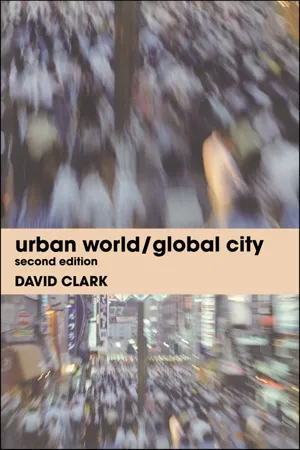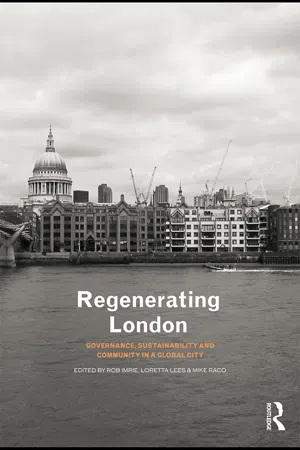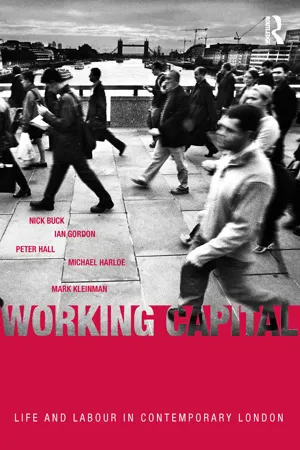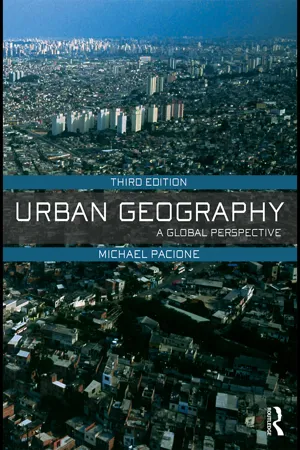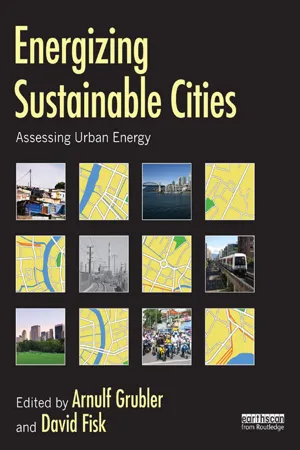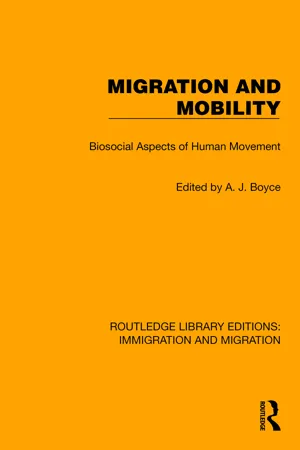Geography
London Urbanisation
London urbanisation refers to the process of growth and expansion of the city of London, including the development of infrastructure, housing, and commercial areas. This urbanisation has been driven by factors such as population growth, economic opportunities, and transportation advancements. As a result, London has transformed into a major global city with a diverse and dynamic urban landscape.
Written by Perlego with AI-assistance
Related key terms
Related key terms
1 of 4
Related key terms
1 of 3
10 Key excerpts on "London Urbanisation"
- eBook - ePub
- David Clark(Author)
- 2004(Publication Date)
- Routledge(Publisher)
3Urban growth and urbanisation: historical patterns
By the end of this chapter you should:- be able to distinguish between urban growth, urbanisation and the spread of urbanism;
- understand the main ways in which urban growth and urbanisation are occurring;
- be familiar with the concept of counterurbanisation and understand its causes;
- understand the ways in which the distribution of population in and around cities changes over time;
- be aware of the major changes which have occurred in the course of global urban development and the reasons for them.
Introduction
The present pattern of global urban development is merely the most recent product of processes of urban change that began over 8,000 years ago. It represents an intermediate stage in the progression from a wholly rural to what will possibly be a completely urban world. The global urban pattern is changing in three different and unconnected ways through urban growth, urbanisation and the spread of urbanism. Urban growth occurs when the population of towns and cities rises. Urbanisation refers to the increase in the proportion of the population that lives in towns and cities. Urbanism is the name that is most commonly used to describe the social and behavioural characteristics of urban living that are being extended across society as a whole as people adopt urban values, identities and lifestyles. This chapter and Chapter 4 identify and attempt to identify and account for recent patterns of urban growth and urbanisation at the global scale. The origins and spread of urbanism are the focus of Chapter 6 .Urban growth and urbanisation are separate and independent trends. Urban growth refers to the absolute increase in the size of the urban population. It occurs both through natural increase, which is an excess of births over deaths, and through net in-migration. In most cities both factors operate together and reinforce each other, although the relative balance varies from place to place and at different times. Growth rates are compounded when the in-migrants are young adults. These are the most fertile age group and their influx is likely to raise the rate of natural increase. However, if the in-migrants are predominantly of one sex, the accompanying rate of natural increase is likely to be lower. As an actual rather than a percentage figure, urban growth is not subject to any ceiling. It can take place without urbanisation occurring so long as rural growth occurs at the same rate. It is likely to continue after urbanisation has ceased, as the population, which will all be living in urban places, goes on growing through the excess of births over deaths. - eBook - ePub
Regenerating London
Governance, Sustainability and Community in a Global City
- Rob Imrie, Loretta Lees, Mike Raco(Authors)
- 2009(Publication Date)
- Routledge(Publisher)
et al., 2002; Hall, 1989; Thornley, 1992). Likewise, much has been written about the social histories of London, and there are numerous literary accounts of the life and times of London’s population (Ackroyd, 2000; Hall, 2007; Picard, 1997; Porter, 1989; Rasmussen, 1960). This book seeks to build on these contributions by developing the argument that the making of London’s geographies has always been related closely to interventions in, and actions upon, physical spaces in the capital and, as such, much more focus on the topic is warranted.In this book we use the term ‘urban regeneration’ as a normative concept that is rooted in British urban policy. It refers to those policies and strategies that have been designed to deal with urban decline, decay and social and economic transformation in London. Urban regeneration implies an integrated perspective on the problems and potentials of cities. Roberts (2000: 17) defines it as a ‘comprehensive and integrated vision and action which leads to the resolution of urban problems and which seeks to bring about a lasting improvement in the economic, physical, social and environmental condition of an area that has been subject to change’. Couch et al. (2003: 2) state that urban regeneration is ‘concerned with the re-growth of economic activity where it has been lost; the restoration of social function where there has been dysfunction, or social inclusion where there has been exclusion; and the restoration of environmental quality or ecological balance where it has been lost’.The chapters in the book seek to develop, in a variety of ways, at least three interrelated understandings of urban regeneration in London. First, policy approaches to London’s regeneration have to be understood as part of the capital’s interplay with broader, national state policy programmes and forms of restructuring of welfare provision. In Cochrane’s (2007) terms, urban, spatial, policies and programmes are closely entwined with (national) social policy measures and interventions. Second, the regeneration of London has also to be set, and understood, within the broadcloth of international relations and transnational processes relating to the capital’s position as a global city and as a pre-eminent player in the global economy. Third, while in aggregate terms urban regeneration in London seems to be successful in facilitating economic and cultural regeneration, it is faring much less well in terms of social inclusion and social sustainability, and may well be implicated in contributing to the widening of social and economic inequalities. - eBook - ePub
Eastern and Southern Africa
Development Challenges in a volatile region
- Debby Potts, T.A.S. Bowyer-Bower(Authors)
- 2016(Publication Date)
- Routledge(Publisher)
These shifts in the urban policy environment over time provide the backdrop to this chapter on urbanisation in eastern and southern Africa. Urbanisation is too broad a topic to provide comprehensive coverage of all its facets. Here the focus is mainly on processes within cities, rather than debates about urban systems and hierarchies. First, the nature and composition of urban growth rates over time are analysed. Second, changes in the way urban people make their livings are examined. Finally, as an example of trends in urban service provision, the urban housing sector is discussed.Urban growth in eastern and southern AfricaMany cities and towns in the region are not growing nearly as fast as they did in the 1960s and 1970s. A number of reasons can be advanced to explain this. Some of them are basic characteristics of urbanisation processes, although they are seemingly often forgotten by regional urban analysts. One important factor is that a given number of net in-migrants to centres with small populations translates into high rates of annual population growth, but yields a much smaller growth rate if added to a much larger urban centre. Also, in countries with extremely low levels of urbanisation, the pool of potential rural–urban migrants in relation to current urban residents is huge: thus as urban levels increase (e.g. to over 50 per cent in today’s South Africa), even if the propensity to migrate to town from rural areas remains the same, the rate of growth yielded by in-migration drops significantly. This means that as urban centres get bigger, and as the population becomes more urbanised, the rates of growth naturally tend to drop.2 - eBook - ePub
Working Capital
Life and Labour in Contemporary London
- Nick Buck, Ian Gordon, Peter Hall, Michael Harloe, Mark Kleinman(Authors)
- 2013(Publication Date)
- Routledge(Publisher)
By the mid-1970s then, the region was already beginning to exhibit the complexity of form and function that we noted at the start of this chapter. But within Greater London, the immediate political reaction was (almost inevitably) to deny reality and seek to halt change. In London Docklands, during the mid-1970s, bitter battles were fought over the pattern of future development. In 1973, when consultants suggested that one scenario might involve attracting new international business, the result was a howl of protest and a demand to find a new future for the old docks and the old industries. The government set up a Docklands Joint Committee, which wrangled and did little; the area succumbed to dereliction. It was hard indeed for local communities and Labour-led local councils, whose entire life had been based on the old manufacturing and goods-handling economy, to accept the fact that it might have died. From a more strategic perspective, both the GLC and national government (in the Inner Cities White Paper of 1977) came to see all the emergent social problems of the city in terms of decline, symbolized by falling population and employment in the core areas, and to fix much of the blame on decentralization policies. Thus, New and Expanded Town programmes were frozen and the brief of the Location of Offices Bureau was changed to one of facilitating local moves within London.The Changed Geography of London 2000
Despite such policy shifts, in the following quarter century these processes have continued to operate, intensified in many cases by the impacts of ‘globalization’ and increasingly competitive forms of economic organization. London seeks to maintain and expand its role as provider of high-level specialized services to the world, ranging from banking and finance to entertainment, culture and tourism. But, in the process what manufacturing employment remained in the mid-1970s has now very largely gone, while the port has been reduced to a shadow of its former importance, located well outside Greater London's boundaries at Tilbury. Gentrification (already underway in the 1960s) has spread its way across a large proportion of Inner London's traditional working-class residential areas, and has begun to affect the outer suburbs too. Huge public housing programmes continued into the early 1980s to replace other working-class areas with planners’ visions, some of which themselves deteriorated into unloved social ghettos. And, since then, new waves of immigration from an increasing variety of origins (not just the West Indies and India/Pakistan as in the previous period) have created ethnically-distinct areas with their own shops, social networks and places of worship.In consequence, each piece of the 1950 geography has been changed more or less radically. In the OMA this largely involved a consolidation and extension of the processes and patterns laid down in the previous period, with further development in successful areas starting to meet more Nimbyist resistance. But within inner parts of London change clearly accelerated and started to shift direction. New service functions, and the growth of older ones, extended the old central area into a wide east-west corridor, with the western end in the White City and Hammersmith, and the eastern end in Docklands, currently in the Isle of Dogs but expanding to reach the Royal Docks, and soon Stratford. As well as the two traditional cores, the City and Westminster/West End, this expanded central area has a third at Canary Wharf in the east, employing close on 50,000 but likely soon to expand to 100,000 and to embrace the Royals and Stratford, as well as subsidiary centres at White City (television and radio), and Hammersmith (consultancy) in the west and on the South Bank (culture, entertainment and tourism). Areas, that in 1950 were still primarily residential, have become largely or partly commercial or governmental: hotels in South Kensington, embassies in Belgravia, offices in Mayfair and St James's. Covent Garden has lost its market to the fringe of the central area in Nine Elms, Billingsgate to Docklands, Spitalfields Market to Leyton. Fleet Street has almost entirely lost its newspaper industry to Docklands and locations even wider afield. - eBook - ePub
Urban Geography
A Global Perspective
- Michael Pacione(Author)
- 2009(Publication Date)
- Routledge(Publisher)
Chapter 1 , in approaching a subject for the first time it is useful to begin by obtaining an overview of the main conceptual approaches, themes and issues that comprise the field. In this chapter we describe the scope of urban geography and its links with other branches of geography. We define the concept of urban and explain the value of an urban geographical perspective for an understanding of contemporary towns and cities. We establish the academic context for the study of urban geography by providing a brief history of the subject. In this discussion we relate work in urban geography to the major theoretical developments in the discipline of geography. Finally, we employ the concept of levels of analysis to illustrate the kind of research undertaken by urban geographers from the global to the local scale.THE SCOPE OF URBAN GEOGRAPHYUrban geographers are concerned to identify and explain the distribution of towns and cities and the socio-spatial similarities and contrasts that exist within and between them. There are thus two basic approaches to urban geography:- The first refers to the spatial distribution of towns and cities and the linkages between them: the study of systems of cities.
- The second refers to the internal structure of urban places: the study of the city as a system.
In essence, urban geography may be defined as the study of cities as systems within a system of cities.1 Figure 2.1 indicates the scope of urban geography as well as the subdiscipline’s links with other branches of geography. The diagram also indicates the power of urban geography to synthesise many different perspectives so as to advance our understanding of urban phenomena. This eclectic approach to the analysis of urban places extends beyond geography to incorporate research findings and knowledge across traditional disciplinary boundaries. The integrative power of urban geography is a key characteristic of the subdiscipline.A second principal characteristic of geographical analysis of the city is the centrality of a spatial perspective. This distinguishes urban geography from cognate areas of urban study such as urban economics, urban sociology or urban politics. We shall see later that there is a long-standing debate among social scientists over the relative importance of spatial and social forces for the explanation of urban phenomena. However, as we saw in Chapter 1 , it is important to be clear about the place of space in urban geography. By acknowledging the importance of spatial location we are not implying that space per se is the key explanatory variable underlying patterns of human activity in the city. The significance of space varies with context. For example, spatial location is of no real significance in the electronic hyperspace occupied by flows of finance between cities in the global economy but may be of fundamental importance for the spread of infectious diseases in a Third World squatter settlement. The spatial perspective of urban geography is of real analytical value because, as Massey (1985)2 - 1 URBANISATION AND THE URBAN QUESTIONFor the vast majority, cities are polluted, unhealthy, tiring, overwhelming, confusing, alienating. They are places of … insecurity, poor living conditions and dejected isolation for the many at the bottom of the social ladder daily sucked into them.(Amin 2006: 1019)It has become something of a cliché to ascertain that we now live in an urban world where most of the world’s population resides in settlements described as urban. Given this, it follows logically that the majority of research in human geography relates to cities in some shape or form, and comments on the social, economic or political circumstances faced by urbanised populations. Likewise, most geographical knowledge production occurs in universities and research institutes based in cities, making the city both a key venue of geographic knowledge production, as well as its principal field site. But although most human geography research can be described as urban – in the sense that it is produced in or relates to cities – a surprisingly small amount of contemporary geographical work is concerned with defining the city itself. To put this somewhat differently, while there is much geographical work carried out in cities that contributes to social, economic, political or cultural theory, most say very little, if anything, about urbanisation as a process. In fact, in the vast majority of the human geographical research that has the city as its context or backdrop, the question of what constitutes ‘cityness’ remains elusive.This said, there are multiple theories of urbanisation developed by sociologists and urban scholars over the last 150 years or so which provide some inroads into this issue. Crucially, these theories do not define cities in terms of what they contain (i.e. internal attributes like population size or density) but instead theorise urbanism as a distinct ‘way of life’, fundamentally different from the forms of life evident in more traditional, rural societies. In these theories, there is a degree of conflation between the emergence of cities and the emergence of modern societies, with some accounts inferring these are one and the same (i.e., modern society is a society of cities). This means that some traditional theories of urbanisation say remarkably little about the role of cities in creating, and sustaining, modern society (Brenner 2009). Redressing this, new approaches to the study of urbanisation emerged from the 1970s onwards which explicitly addressed the ‘urban question’ – namely, what role do cities play in the processes of production and exchange that are integral to capitalist society? This is a question at the heart of urban political economy , a theoretical approached largely indebted to the ideas of Karl Marx. Reflecting the current hold Marxist and neo-Marxist thought has on urban studies, this chapter charts the shift from descriptive to more critical urban theories, and the move from questions of what the city is , to what the city does
- eBook - ePub
Towns and Cities
Competing for survival
- Angus McIntosh(Author)
- 2003(Publication Date)
- Taylor & Francis(Publisher)
Population change yet more counter-urbanization?The residential populations of all towns and cities are always changing; they may be expanding or contracting, becoming more youthful or ageing, or changing in terms of their socio-economic composition. Over time these changes become reflected in the way towns and cities use their land. As E.F. Schumacher stated in Small is Beautiful: ‘Among material resources, the greatest, unquestionably, is the land. Study how society uses its land, and you can come to pretty reliable conclusions as to what its future will be.’The computerization of demographic information nowadays provides both investors in the private sector, as well as administrators in the public sector, with a useful tool to understand land in urban areas. However, as will be discussed in Chapter 7 , as an aid to more enlightened town planning (or urban management), there is very little evidence that this data has been used successfully in strategic planning.Population change
The last half century has been characterized by a continuing process of counter-urbanization. Generally the larger cities have continued to lose population—a phenomenon which has been common in many mature economies. Between 1961 and 1991, inner London lost more than one million residents, a quite staggering decrease. Manchester and Liverpool have both experienced larger percentage declines, but even combining these two cities together, the number of people who migrated outwards is still less than the decline in the number of residents in inner London.Over the same 30-year period, Glasgow has shown the largest decline, a drop of 43%, while Edinburgh has seen nearly a quarter of its population disappear. With the exception of inner London, the statistics show that the real acceleration in urban population decline took place after 1971; only inner London had shown a significant fall in population in the previous decade. Some of the cities in decline since 1961 are listed in Table 2.1 - eBook - ePub
Energizing Sustainable Cities
Assessing Urban Energy
- Arnulf Grubler, David Fisk(Authors)
- 2012(Publication Date)
- Routledge(Publisher)
Chapter 9 ). Following these different disciplinary perspectives, four complementary concepts describe the process of urbanization:- The demographer's approach emphasizes population. To a demographer, urbanization is the process by which a rural population becomes urban, either by people migrating from rural to urban places or by a transformation of a rural settlement into an urban settlement. That is, the population is becoming urbanized reflected by an increase in the proportion of the population classified as urban dwellers.
- In the geographer's approach, a defined geographic area gradually loses the characteristics associated with rural areas (e.g., dominance of agricultural land uses) and gains characteristics associated with urban areas (e.g., built-up land, and high density of buildings and technological infrastructures such as mains drainage) — the region is becoming urbanized.
- The economist's approach focuses on the process of economic structural change away from primary economic activities (agriculture, forestry, mining, etc.) toward manufacturing and services (secondary and tertiary economic activities) where typically capital increasingly substitutes for labor. This usually involves spatial concentration and co-location of economic actors1 that profit from agglomeration externalities: the economy is becoming urbanized.
- In the sociologist's approach individuals (and family units) move from rural to urban areas, and take on urban characteristics: individuals and their aggregate (i.e., society) are becoming urbanized.
The demographic study of urbanization is among the oldest research traditions and also the most quantitative, including scenario projections into the future. Along with economics it is also the dimension with the closest direct causal link to urban energy use. This is the reason why in the subsequent discussion the demographic perspective of urbanization is highlighted. The economic, geographical, and sociological perspectives of urbanization in turn are discussed in greater detail as driving forces of urban energy demand (Chapter 9 - eBook - ePub
Migration and Mobility
Biosocial Aspects of Human Movement
- A.J. Boyce, A.J. Boyce, A.J. Boyce(Authors)
- 2022(Publication Date)
- Routledge(Publisher)
INTER-URBAN MIGRATION IN BRITAIN: A GEOGRAPHICAL PERSPECTIVE
J.H. JOHNSONDepartment of Geography, University of Lancaster, Bailrigg, Lancaster LA 1 4YW, UKINTRODUCTION
As societies, economies and transport systems become modernized, then more frequent, longer, and more complex movements of population commonly take place. As this spatial mobility of population grows, the resulting diverse movements of population become more and more difficult to fit into an easy typology; but a critical distinction must be made between temporary movements connected with everyday activities and those moves which involve a change of home, with the social and economic costs that this entails (figure 1 ). Not that the two types are independent, since temporary movements provide the opportunity to acquire the information which may lead to permanent migration. For example, retirement moves are often made to resort areas known earlier in life and intra-urban residential moves are frequently made to sectors of the city which are known for other reasons. Focusing on permanent moves (in so far as the term ‘permanent’ can be applied to any population movement in modern urban society), a critical distinction is between those moves which simply involve a change of residence and those which also involve a change in employment (Johnson 1976 ). The study of ‘ labour migration’ – the simultaneous change of job and of home – has taken on greater importance in recent decades for a number of inter-related reasons.FIGURE 1. Some types of population migration.Reduced levels of fertility are leading to parallel falls in natural increase in many parts of the developed world. In Britain, it is likely that the period of relatively rapid population increase since the end of World War II is at last at an end. As a result, population migration of all types is becoming more important in causing changes in population totals and in modifying local population structures. The importance of migration is not merely demographic. In the past many regionally based planning proposals have often assumed that natural increase would more than offset loss by migration. This assumption has usually proved to be true, at least as far as the population totals of major regions are concerned, although not necessarily at a local scale. It could be quite confidently expected that planning errors in the over-provision of houses or jobs could be corrected in the longer term, as total regional population grew. Now, however, mistakes in the allocation of regional investment appear more difficult to adjust (Johnson & Salt 1981 - eBook - ePub
The Tudor and Stuart Town 1530 - 1688
A Reader in English Urban History
- Jonathan Barry(Author)
- 2014(Publication Date)
- Routledge(Publisher)
17 But it is also clear that London's own rate of growth slowed down considerably in the later decades of the century, although not as sharply as did the growth of the total population: whereas the population of London had doubled between 1600 and 1650, between 1650 and 1700 it increased by less than half as much again. The capital city was thus not increasing at a continuously accelerating rate of growth, although in absolute terms of course its population was still expanding massively. Its great increase in population was fuelled completely by migration into the city from the countryside and from small towns - indeed so high were urban death rates at this time that considerable immigration was needed even to keep the population at par.The emergence of one big city did not in itself entail any automatic consequences for other towns in the economy of the time: it did not spread a universal mantle of growth; nor equally did it spell automatic blight for smaller rivals. The factors promoting London's expansion were partly unique but partly generic. It was unique in that it was the political and administrative capital of a unifying nation-state; and its geographical location gave it a commanding (although not unrivalled) position in the all-important trade between England and the Netherlands. But London also functioned as an industrial centre, as a nodal point for inland trade, and as a service and social centre, none of which activities were intrinsically liable to be confined to the capital city - although it is true that as London expanded it tended to strengthen its dominance in some of these spheres simply by virtue of its size, in a cumulative and self-sustaining process. For instance the volume and variety of inland trade centring upon the capital city naturally multiplied through the need to supply London's inhabitants with food, drink and raw materials. It flourished as a manufacturing centre because it contained the largest single concentration of consumers in the country, in an age when much (though far from all) production was located close to consumer markets. And in the same way the vitality of London's social and cultural life in Tudor and Stuart times also reflected the growing size and prestige of the city, let alone the growing wealth and taste for conspicuous consumption of landed gentlemen (now gaining their town houses) and the affluent citizenry; hence London offered an expanding market for those with professional services to sell and a growing audience for those anxious to make a social splash. It produced a competitive and often ruthless society, where men learnt, in Ben Jonson's words 'to quarrel and live by their wits'.
Index pages curate the most relevant extracts from our library of academic textbooks. They’ve been created using an in-house natural language model (NLM), each adding context and meaning to key research topics.
Explore more topic indexes
Explore more topic indexes
1 of 6
Explore more topic indexes
1 of 4
